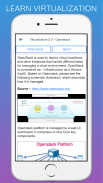










Learn All DevOps Technologies Tutorials Offline ⭐️

Beschreibung von Learn All DevOps Technologies Tutorials Offline ⭐️
Learn Ansible
Ansible is simple open source IT engine which automates application deployment, intra service orchestration, cloud provisioning and many other IT tools.
Learn Bugzilla
Bugzilla is an open-source tool used for issues and bugs tracking system. It is widely used as a bug-reporting tool for all types of testing functions.
Learn Chef
Chef is a configuration management technology developed by Opscode to manage infrastructure on physical or virtual machines.
Learn Consul
Consul is an important service discovery tool in the world of Devops. This tutorial covers in-depth working knowledge of Consul, its setup and deployment.
Learn Docker
This tutorial explains the various aspects of the Docker Container service.
Learn Gerrit
Gerrit is a web-based code review tool, which is integrated with Git and built on top of Git version control system (helps developers to work together and maintain the history of their work).
Learn Git
Git is a distributed revision control and source code management system with an emphasis on speed. Git was initially designed and developed by Linus Torvalds for Linux kernel development.
Learn Gitlab
Gitlab is a service that provides remote access to Git repositories.
Learn Jira
JIRA is a project management tool used for issues and bugs tracking system. It is widely used as an issue-tracking tool for all types of testing.
Learn Kubernetes
Kubernetes is a container management technology developed in Google lab to manage containerized applications in different kind of environments such as physical, virtual, and cloud infrastructure.
Learn LogStash
Logstash is an open-source, centralized, events and logging manager. It is a part of the ELK (ElasticSearch, Logstash, Kibana) stack.
Learn Makefile
Makefile is a program building tool which runs on Unix, Linux, and their flavors. It aids in simplifying building program executables that may need various modules.
Learn Mantis
Mantis is a Bug Reporting tool, widely used as an issue tracking tool for all types of testing. This is a brief tutorial that introduces the readers to the basic features and usage of Mantis.
Learn Nagios
Nagios is the most popular continuous monitoring tool. It monitors complete IT infrastructure including its systems, applications, services processes etc.
OpenShift
OpenShift is a cloud development Platform as a Service (PaaS) developed by Red Hat.
Learn Puppet
Puppet is a configuration management technology to manage the infrastructure on physical or virtual machines.
Learn Saltstack
SaltStack is an open-source configuration management and remote execution engine. It remotely executes commands across all machines. It is a python based software.
Learn Scrapy
Scrapy is a fast, open-source web crawling framework written in Python, used to extract the data from the web page with the help of selectors based on XPath.
Learn SVN
Apache Subversion which is often abbreviated as SVN, is a software versioning and revision control system distributed under an open source license. Subversion was created by CollabNet Inc.
Learn UNIX
Unix is a computer Operating System which is capable of handling activities from multiple users at the same time.
Learn Linux Admin
Linux was designed based on the Unix philosophy of “small, precise tools chained together simplifying larger tasks”.
Learn Ubuntu
This tutorial looks at the various aspects of the Ubuntu Operating system. It discusses various features, flavors, and working of the Ubuntu desktop edition.
Learn Virtualization2.0
Virtualization 2.0 is a technology that helps users to install different Operating Systems on a hardware. They are completely separated and independent from each other.
Learn VersionOne
VersionOne is a project management tool used to track and maintain records of all STLC phases in Agile from backlog to report creation.
Lerne Ansible
Ansible ist eine einfache Open-Source-IT-Engine, die die Anwendungsbereitstellung, die Intra-Service-Orchestrierung, die Cloud-Bereitstellung und viele andere IT-Tools automatisiert.
Lerne Bugzilla
Bugzilla ist ein Open-Source-Tool für das Problem- und Fehlerverfolgungssystem. Es wird häufig als Tool zur Fehlerberichterstattung für alle Arten von Testfunktionen verwendet.
Koch lernen
Chef ist eine von Opscode entwickelte Konfigurationsmanagement-Technologie zur Verwaltung der Infrastruktur auf physischen oder virtuellen Maschinen.
Lerne Konsul
Consul ist ein wichtiges Service Discovery Tool in der Welt der Devops . Dieses Tutorial behandelt detaillierte Kenntnisse über Consul, dessen Einrichtung und Bereitstellung.
Lernen Sie Docker
In diesem Tutorial werden die verschiedenen Aspekte des Docker Container-Dienstes erläutert.
Lerne Gerrit
Gerrit ist ein webbasiertes Tool zur Codeüberprüfung, das in Git integriert ist und auf dem Git-Versionskontrollsystem basiert (hilft Entwicklern, zusammenzuarbeiten und den Verlauf ihrer Arbeit zu pflegen).
Lerne Git
Git ist ein verteiltes Revisionskontroll- und Quellcodeverwaltungssystem mit Schwerpunkt auf Geschwindigkeit. Git wurde ursprünglich von Linus Torvalds für die Linux-Kernel-Entwicklung entworfen und entwickelt.
Lerne Gitlab
Gitlab ist ein Dienst, der Remotezugriff auf Git-Repositorys bietet.
Lerne Jira
JIRA ist ein Projektmanagement-Tool, das zur Verfolgung von Problemen und Fehlern verwendet wird. Es wird häufig als Tool zur Problemverfolgung für alle Arten von Tests verwendet.
Lerne Kubernetes
Kubernetes ist eine Containerverwaltungstechnologie, die im Google-Labor entwickelt wurde, um containerisierte Anwendungen in verschiedenen Umgebungen wie der physischen, virtuellen und Cloud-Infrastruktur zu verwalten.
Lernen Sie LogStash
Logstash ist ein Open-Source-Manager für Ereignisse und Protokollierung. Es ist Teil des ELK-Stacks (ElasticSearch, Logstash, Kibana).
Lerne Makefile
Makefile ist ein Programmerstellungstool, das unter Unix, Linux und ihren Varianten ausgeführt wird. Es hilft bei der Vereinfachung der Erstellung von ausführbaren Programmprogrammen, für die möglicherweise verschiedene Module erforderlich sind.
Lerne Mantis
Mantis ist ein Tool zur Fehlerberichterstattung, das häufig als Tool zur Problemverfolgung für alle Arten von Tests verwendet wird. Dies ist ein kurzes Tutorial, das die Leser in die grundlegenden Funktionen und die Verwendung von Mantis einführt.
Lerne Nagios
Nagios ist das beliebteste kontinuierliche Überwachungstool. Es überwacht die gesamte IT-Infrastruktur einschließlich ihrer Systeme, Anwendungen, Serviceprozesse usw.
OpenShift
OpenShift ist eine von Red Hat entwickelte Cloud Development Platform as a Service (PaaS).
Lerne Marionette
Puppet ist eine Konfigurationsverwaltungstechnologie zur Verwaltung der Infrastruktur auf physischen oder virtuellen Maschinen.
Saltstack lernen
SaltStack ist eine Open-Source-Engine für Konfigurationsmanagement und Remote-Ausführung. Es führt Befehle remote auf allen Computern aus. Es ist eine Python-basierte Software.
Lerne Scrapy
Scrapy ist ein schnelles, in Python geschriebenes Open-Source-Webcrawling-Framework, mit dem die Daten mithilfe von auf XPath basierenden Selektoren von der Webseite extrahiert werden.
Lerne SVN
Apache Subversion, das häufig als SVN abgekürzt wird, ist ein Softwareversions- und Revisionskontrollsystem, das unter einer Open Source-Lizenz vertrieben wird. Subversion wurde von CollabNet Inc. erstellt.
Lernen Sie UNIX
Unix ist ein Computer-Betriebssystem, das Aktivitäten von mehreren Benutzern gleichzeitig ausführen kann.
Lernen Sie Linux Admin
Linux wurde basierend auf der Unix-Philosophie entwickelt, „kleine, präzise Tools, die miteinander verkettet sind und größere Aufgaben vereinfachen“.
Lerne Ubuntu
Dieses Tutorial befasst sich mit den verschiedenen Aspekten des Ubuntu-Betriebssystems. Es werden verschiedene Funktionen, Varianten und Funktionen der Ubuntu Desktop Edition erläutert.
Lernen Sie Virtualization 2.0
Virtualization 2.0 ist eine Technologie, mit der Benutzer verschiedene Betriebssysteme auf einer Hardware installieren können. Sie sind völlig getrennt und unabhängig voneinander.
Lerne VersionOne
VersionOne ist ein Projektmanagement-Tool, mit dem Aufzeichnungen aller STLC-Phasen in Agile vom Rückstand bis zur Berichterstellung verfolgt und verwaltet werden.


























